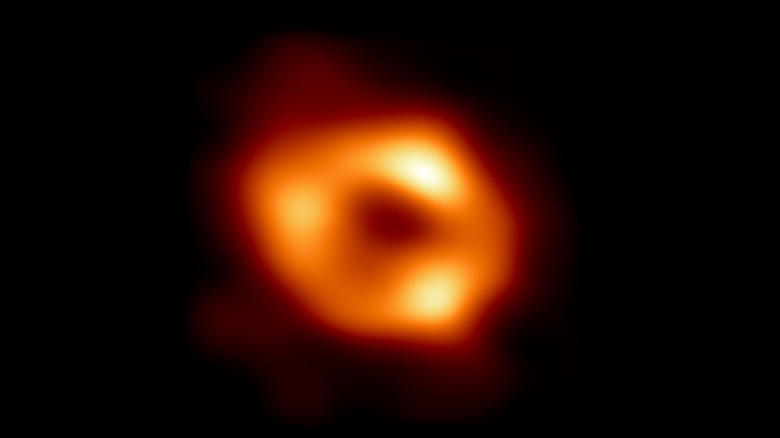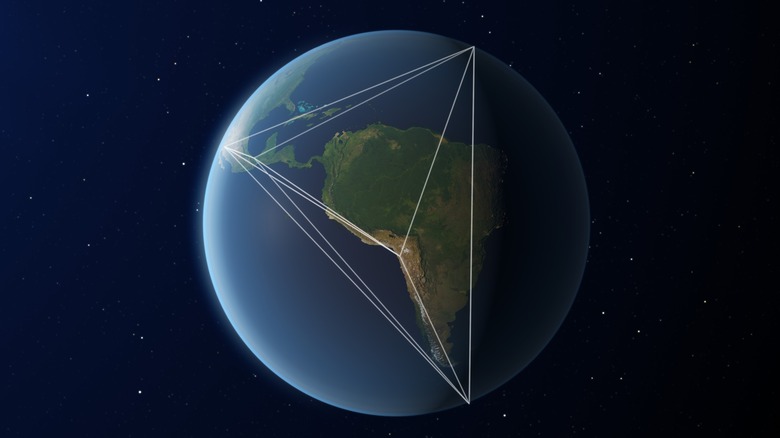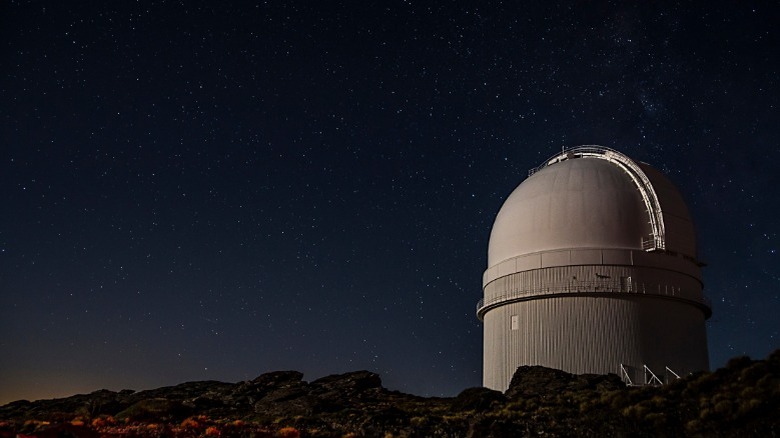Event Horizon Telescope Captures First Image Of The Milky Way's Supermassive Black Hole
In what is being hailed as one of the biggest astronomy achievements of the past few years, scientists have managed to capture the first picture depicting the supermassive black hole at the center of the Milky Way galaxy (via the European Southern Observatory). This also happens to be only the second picture of a black hole ever captured after the one called M87 in the Messier galaxy. Known to the astronomy community as Sagittarius A* (Sgr A*), the supermassive black hole at the heart of our home galaxy appears as a lumpy mass of darkness surrounded by bright gas in roughly the shape of a doughnut.
Located about 27,000 light-years away from Earth, the size of the black hole as it appears in the sky is roughly the sky size equivalent of putting a doughnut on the moon. The image was captured Event Horizon Telescope, which is a "virtual telescope" linking and pulling data from eight different observatories around the world.
The bid to picture the hulking black hole, which is nearly four million times more massive than the Sun, began back in 2017 with multi-hour image capture, the same technique that is used for capturing long-exposure light trail shots of the night sky. However, snapping a picture of Sagittarius A* was not easy, with the team behind the research likening the endeavor to "trying to take a clear picture of a puppy quickly chasing its tail." The aforementioned difficulty has to do with the vicinity and size of Sgr A*.
Capturing a rare cosmic sight
First, Sagittarius A* is a lot closer to the observation points on Earth than M87, which is about 53 million light-years away from our planet. Plus, it is nearly a thousand times bigger than Milky Way's own supermassive black hole. Thanks to the size disparity, gas clouds around M87 appear to move slower as they take anywhere between a few days to weeks to orbit around it. In the case of Sgr A*, the orbit period for gas clouds is merely nine minutes.
With gas moving at near light speed, the change in gas patterns and variable brightness levels made it a lot more difficult to create a composite image — given the massive amount of observation data collected — and churn it all using a supercomputer. New imaging tools had to be developed, and it took a team of over 300 experts hailing from 80 institutes across the world to image Sgr A*.
The team is now focused on studying all the observation data to understand the behavior of gas around supermassive black holes and test existing theoretical models to learn more about the origin and evolution of galaxies. As for the collaboration that led to this massive achievement, work is already underway to expand the scope of the EHT project so that more black holes can be captured, allowing us to learn more about these enigmatic cosmic behemoths.
What's next for the Event Horizon Telescope?
Imaging the supermassive black hole at the center of the Milky Way was one of the main goals of this project, but the Event Horizon Telescope isn't done yet. In fact, it sounds like there's still plenty of action ahead for the Event Horizon Telescope. During a news conference announcing the imaging of Sagittarius A*, scientists working with the U.S. National Science Foundation and the Event Horizon Telescope Collaboration explained that one of the goals moving forward will be to produce movies that show off the rotation of these black holes. Scientists have been attempting to make movies of black holes since 2017, when M87 was first imaged.
"We did try this with the 2017 data," said Caltech's Katie Bouman. Bouman went on to explain that scientists working with the Event Horizon Telescope "developed algorithms that allowed us to not just make static images, but movies, and we applied these to the data." Unfortunately, this process didn't result in videos that scientists were confident sharing. Still, work is progressing toward videos that will allow us to see the action around these black holes.
According to Vincent Fish with MIT's Haystack Observatory, the observatories that comprise the Event Horizon Telescope are undergoing "a series of technical developments" that will allow for easier, longer observations of black holes like M87 – which will be the easier of the two black holes to image. Fish says that those new capabilities will be in place in a couple of years, so it may not be too much longer before we actually get to see the rotation of gasses around M87.
Seeing black holes in a new light
In the more immediate future, however, it sounds like we'll get to see Sagittarius A* in a new light. Michael Johnson from the Harvard-Smithsonian Center for Astrophysics says producing polarized images of Sagittarius A* will probably be the "next step" for Event Horizon scientists.
"It's hard to convey just how much more information there is here," Johnson explained. "So, progressively, here you're only seeing the total intensity of the light that's being emitted. Our next step will probably be to make polarized images of Sgr A*, where we can see the magnetic fields near the black hole and see how they're dragged by the black hole itself. In addition to that, this is a single-color image. We're denoting brightness by the color here, but it's really some equivalent to a black and white image for us. And so we're looking at expanding to observing with multiple frequencies to really see an image in color, and that will tell us enormously more about the source."
In other words, this is just the beginning. As the Event Horizon Telescope is expanded with more telescopes from around the world and the technical upgrades that Fish mentioned are applied, it sounds like our understanding of the black hole at the center of our galaxy will become more comprehensive.


